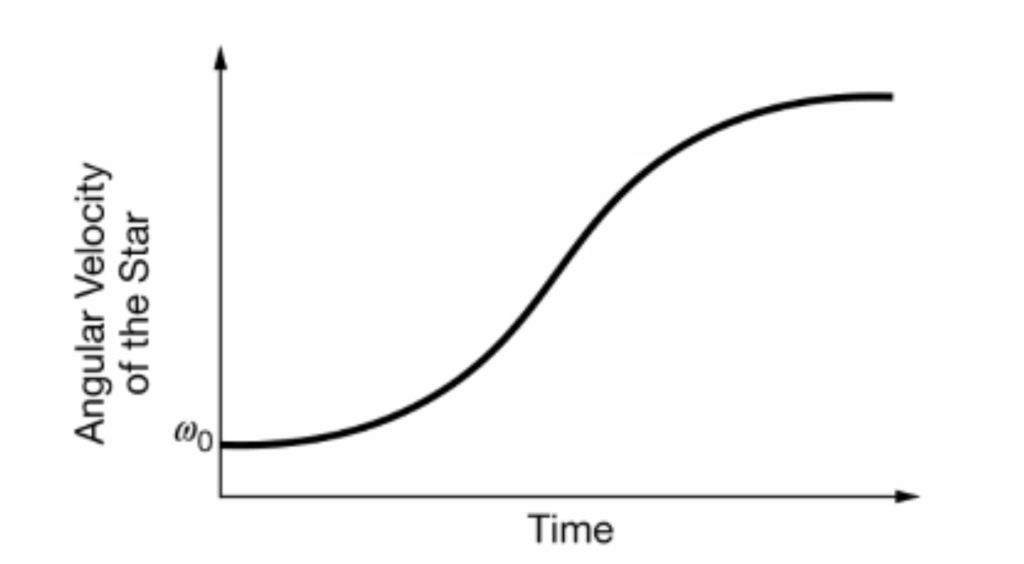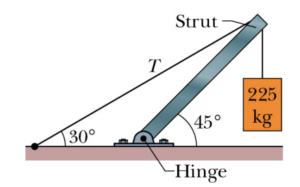0 attempts
0% avg
UBQ Credits
# Part (a): At what time does the motor reverse direction?
| Step | Derivation/Formula | Reasoning |
|---|---|---|
| 1 | [katex]\omega = 20 – \frac{1}{2}t^2[/katex] | Given the angular velocity of the electric motor as a function of time. |
| 2 | [katex]\omega = 0[/katex] | To find the time when the motor reverses direction, set the angular velocity [katex]\omega[/katex] equal to zero. |
| 3 | [katex]0 = 20 – \frac{1}{2}t^2[/katex] | Substitute [katex]\omega = 0[/katex] into the given angular velocity equation. |
| 4 | [katex]\frac{1}{2}t^2 = 20 [/katex] | Rearrange the equation to solve for [katex]t^2[/katex]. |
| 5 | [katex]t^2 = 40[/katex] | Multiply both sides by 2 to isolate [katex]t^2[/katex]. |
| 6 | [katex]t = \sqrt{40}[/katex] | Solve for [katex]t[/katex] by taking the square root of both sides. Include only the positive root because time cannot be negative. |
| 7 | [katex]t = \boxed{6.32 \, \text{s}}[/katex] | Final answer: The motor reverses direction at [katex] t = 6.32 \, \text{s} [/katex]. |
# Part (b): Through what angle does the motor turn between [katex]t=0 \, \text{s}[/katex] and [katex]t=8 \, \text{s}[/katex]?
Note – If you haven’t learned calculus yet, plot the given \( \omega\) v \(t\) equation. Then approximate the area bound by the line and the x axis, up to the 8 second mark. This area represents the angular displacement of the motor.
| Step | Derivation/Formula | Reasoning |
|---|---|---|
| 1 | [katex]\theta = \int_0^t \omega \, dt[/katex] | The angle [katex]\theta[/katex] through which the motor turns is the integral of angular velocity over time. |
| 2 | [katex]\theta = \int_0^8 \left(20 – \frac{1}{2} t^2 \right) dt [/katex] | Substitute the given angular velocity expression into the integral and set the limits from [katex] t = 0 \, \text{s} [/katex] to [katex] t = 8 \, \text{s} [/katex]. |
| 3 | [katex]\theta = \left[ 20t – \frac{1}{2} \cdot \frac{t^3}{3} \right]_0^8[/katex] | Integrate the expression term by term: [katex]\int 20 \, dt = 20t[/katex] and [katex]\int -\frac{1}{2}t^2 \, dt = -\frac{1}{2} \cdot \frac{t^3}{3}[/katex]. |
| 4 | [katex]\theta = \left[ 20t – \frac{t^3}{6} \right]_0^8 [/katex] | Simplify the integrated expression. |
| 5 | [katex]\theta = \left( 20 \times 8 – \frac{8^3}{6}\right) – \left( 20 \times 0 – \frac{0^3}{6} \right)[/katex] | Evaluate the expression at the limits: [katex] t = 8 \, \text{s} [/katex] and [katex] t = 0 \, \text{s} [/katex]. |
| 6 | [katex]\theta = \left( 160 – \frac{512}{6} \right) – 0[/katex] | Simplify and calculate the values. |
| 7 | [katex]\theta = 160 – 85.33[/katex] | Subtract the second term from the first term to find the angle. |
| 8 | [katex]\theta = \boxed{74.67 \, \text{rad}}[/katex] | The motor turns through an angle of [katex] 74.67 \, \text{rad} [/katex] between [katex] t = 0 \, \text{s} [/katex] and [katex] t = 8 \, \text{s} [/katex]. |
Just ask: "Help me solve this problem."

An isolated spherical star of radius [katex] R_o [/katex], rotates about an axis that passes through its center with an angular velocity of [katex] \omega_o [/katex]. Gravitational forces within the star cause the star’s radius to collapse and decrease to a value [katex] r_o <R_o [/katex], but the mass of the star remains constant. A graph of the star’s angular velocity as a function of time as it collapses is shown. Which of the following predictions is correct about the angular momentum [katex] L [/katex] of the star immediately after the collapse?
A discus is held at the end of an arm that starts at rest. The average angular acceleration of [katex]54 \, \text{rad/s}^2 [/katex] lasts for 0.25 s. The path is circular and has radius 1.1 m.
Note: A discuss is a heavy, flattened circular object for throwing.
A uniform solid sphere of mass M and radius R is placed on a frictionless horizontal surface. A massless string is wrapped around the sphere and is pulled with a force F. The string makes an angle of θ with the horizontal. What is the minimum value of the coefficient of static friction between the sphere and the surface required for the sphere to start rolling without slipping?

The system in the Figure is in equilibrium. A concrete block of mass 225 kg hangs from the end of a uniform strut whose mass is 45.0 kg.

In lacrosse, a typical throw is made by rotating the stick through an angle of roughly \(90^\circ\), then releasing the ball when the stick is vertical, as shown above. If the \(1 \, \text{meter}\) long stick is at rest when horizontal and the ball leaves the stick with a velocity of \(10 \, \text{m/s}\), what angular acceleration must the stick experience?
By continuing you (1) agree to our Terms of Use and Terms of Sale and (2) consent to sharing your IP and browser information used by this site’s security protocols as outlined in our Privacy Policy.
| Kinematics | Forces |
|---|---|
| \(\Delta x = v_i t + \frac{1}{2} at^2\) | \(F = ma\) |
| \(v = v_i + at\) | \(F_g = \frac{G m_1 m_2}{r^2}\) |
| \(v^2 = v_i^2 + 2a \Delta x\) | \(f = \mu N\) |
| \(\Delta x = \frac{v_i + v}{2} t\) | \(F_s =-kx\) |
| \(v^2 = v_f^2 \,-\, 2a \Delta x\) |
| Circular Motion | Energy |
|---|---|
| \(F_c = \frac{mv^2}{r}\) | \(KE = \frac{1}{2} mv^2\) |
| \(a_c = \frac{v^2}{r}\) | \(PE = mgh\) |
| \(T = 2\pi \sqrt{\frac{r}{g}}\) | \(KE_i + PE_i = KE_f + PE_f\) |
| \(W = Fd \cos\theta\) |
| Momentum | Torque and Rotations |
|---|---|
| \(p = mv\) | \(\tau = r \cdot F \cdot \sin(\theta)\) |
| \(J = \Delta p\) | \(I = \sum mr^2\) |
| \(p_i = p_f\) | \(L = I \cdot \omega\) |
| Simple Harmonic Motion | Fluids |
|---|---|
| \(F = -kx\) | \(P = \frac{F}{A}\) |
| \(T = 2\pi \sqrt{\frac{l}{g}}\) | \(P_{\text{total}} = P_{\text{atm}} + \rho gh\) |
| \(T = 2\pi \sqrt{\frac{m}{k}}\) | \(Q = Av\) |
| \(x(t) = A \cos(\omega t + \phi)\) | \(F_b = \rho V g\) |
| \(a = -\omega^2 x\) | \(A_1v_1 = A_2v_2\) |
| Constant | Description |
|---|---|
| [katex]g[/katex] | Acceleration due to gravity, typically [katex]9.8 , \text{m/s}^2[/katex] on Earth’s surface |
| [katex]G[/katex] | Universal Gravitational Constant, [katex]6.674 \times 10^{-11} , \text{N} \cdot \text{m}^2/\text{kg}^2[/katex] |
| [katex]\mu_k[/katex] and [katex]\mu_s[/katex] | Coefficients of kinetic ([katex]\mu_k[/katex]) and static ([katex]\mu_s[/katex]) friction, dimensionless. Static friction ([katex]\mu_s[/katex]) is usually greater than kinetic friction ([katex]\mu_k[/katex]) as it resists the start of motion. |
| [katex]k[/katex] | Spring constant, in [katex]\text{N/m}[/katex] |
| [katex] M_E = 5.972 \times 10^{24} , \text{kg} [/katex] | Mass of the Earth |
| [katex] M_M = 7.348 \times 10^{22} , \text{kg} [/katex] | Mass of the Moon |
| [katex] M_M = 1.989 \times 10^{30} , \text{kg} [/katex] | Mass of the Sun |
| Variable | SI Unit |
|---|---|
| [katex]s[/katex] (Displacement) | [katex]\text{meters (m)}[/katex] |
| [katex]v[/katex] (Velocity) | [katex]\text{meters per second (m/s)}[/katex] |
| [katex]a[/katex] (Acceleration) | [katex]\text{meters per second squared (m/s}^2\text{)}[/katex] |
| [katex]t[/katex] (Time) | [katex]\text{seconds (s)}[/katex] |
| [katex]m[/katex] (Mass) | [katex]\text{kilograms (kg)}[/katex] |
| Variable | Derived SI Unit |
|---|---|
| [katex]F[/katex] (Force) | [katex]\text{newtons (N)}[/katex] |
| [katex]E[/katex], [katex]PE[/katex], [katex]KE[/katex] (Energy, Potential Energy, Kinetic Energy) | [katex]\text{joules (J)}[/katex] |
| [katex]P[/katex] (Power) | [katex]\text{watts (W)}[/katex] |
| [katex]p[/katex] (Momentum) | [katex]\text{kilogram meters per second (kgm/s)}[/katex] |
| [katex]\omega[/katex] (Angular Velocity) | [katex]\text{radians per second (rad/s)}[/katex] |
| [katex]\tau[/katex] (Torque) | [katex]\text{newton meters (Nm)}[/katex] |
| [katex]I[/katex] (Moment of Inertia) | [katex]\text{kilogram meter squared (kgm}^2\text{)}[/katex] |
| [katex]f[/katex] (Frequency) | [katex]\text{hertz (Hz)}[/katex] |
General Metric Conversion Chart
Example of using unit analysis: Convert 5 kilometers to millimeters.
Start with the given measurement: [katex]\text{5 km}[/katex]
Use the conversion factors for kilometers to meters and meters to millimeters: [katex]\text{5 km} \times \frac{10^3 \, \text{m}}{1 \, \text{km}} \times \frac{10^3 \, \text{mm}}{1 \, \text{m}}[/katex]
Perform the multiplication: [katex]\text{5 km} \times \frac{10^3 \, \text{m}}{1 \, \text{km}} \times \frac{10^3 \, \text{mm}}{1 \, \text{m}} = 5 \times 10^3 \times 10^3 \, \text{mm}[/katex]
Simplify to get the final answer: [katex]\boxed{5 \times 10^6 \, \text{mm}}[/katex]
Prefix | Symbol | Power of Ten | Equivalent |
|---|---|---|---|
Pico- | p | [katex]10^{-12}[/katex] | 0.000000000001 |
Nano- | n | [katex]10^{-9}[/katex] | 0.000000001 |
Micro- | µ | [katex]10^{-6}[/katex] | 0.000001 |
Milli- | m | [katex]10^{-3}[/katex] | 0.001 |
Centi- | c | [katex]10^{-2}[/katex] | 0.01 |
Deci- | d | [katex]10^{-1}[/katex] | 0.1 |
(Base unit) | – | [katex]10^{0}[/katex] | 1 |
Deca- or Deka- | da | [katex]10^{1}[/katex] | 10 |
Hecto- | h | [katex]10^{2}[/katex] | 100 |
Kilo- | k | [katex]10^{3}[/katex] | 1,000 |
Mega- | M | [katex]10^{6}[/katex] | 1,000,000 |
Giga- | G | [katex]10^{9}[/katex] | 1,000,000,000 |
Tera- | T | [katex]10^{12}[/katex] | 1,000,000,000,000 |
The most advanced version of Phy. 50% off, for early supporters. Prices increase soon.
per month
Billed Monthly. Cancel Anytime.
Trial –> Phy Pro
We crafted THE Ultimate A.P Physics 1 course so you can learn faster and score higher.
Try our free calculator to see what you need to get a 5 on the upcoming AP Physics 1 exam.
A quick explanation
Credits are used to grade your FRQs and GQs. Pro users get unlimited credits.
Submitting counts as 1 attempt.
Viewing answers or explanations count as a failed attempts.
Phy gives partial credit if needed
MCQs and GQs are are 1 point each. FRQs will state points for each part.
Phy customizes problem explanations based on what you struggle with. Just hit the explanation button to see.
Understand you mistakes quicker.

Phy automatically provides feedback so you can improve your responses.
10 Free Credits To Get You Started

By continuing you agree to nerd-notes.com Terms of Service, Privacy Policy, and our usage of user data.
NEW! PHY AI accurately solves all questions
🔥 Get up to 30% off Elite Physics Tutoring
🧠 NEW! Learn Physics From Scratch Self Paced Course
🎯 Need exam style practice questions?